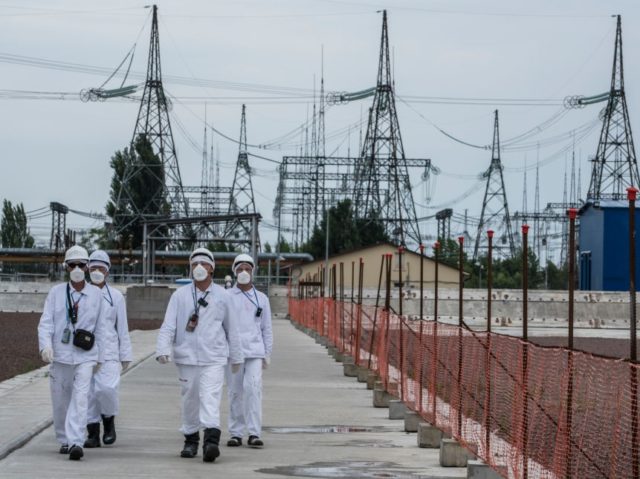President Volodymyr Zelensky of Ukraine debuted Wednesday a new campaign to make the Chernobyl exclusion zone more welcoming to scientists and tourists.
The plan was introduced alongside the debut of the New Safe Confinement (NSC), a $1.7 billion containment vessel for the remains of Chernobyl’s destroyed nuclear plant.
Zelensky said his government would move to eradicate endemic corruption in the Chernobyl exclusion zone, currently open to tourists often forced to pay bribes to random police officers they encounter on their way to the abandoned town of Pripyat, and great a “green corridor” that is safe for tourists to visit and explore the lush natural preserve that has developed around the plant due to the absence of humans.
The Chernobyl Nuclear Power Plant melted down on April 26, 1986, the product of Soviet incompetence and political secrecy. During a regular safety test, one of the plant’s reactors began to overheat. Rather than attempt to cool the reactor, authorities increased the amount of power going into it, causing a blast. The meltdown killed 31 people in its immediate wake. Thousands have died since of various cancers, heart disease, and other health conditions in the affected region, as well as suicide in response to the tremendous mental trauma the event caused. There is no agreed upon death toll for the Chernobyl nuclear disaster, the worst of its kind in history, but the World Health Organization (WHO) estimated in 2005 that 4,000 people suffered related cancers in the aftermath of the meltdown. Other estimates have found as many as 70,000 deaths via cancer and radiation poisoning directly related to the disaster.
“Chernobyl has been a negative part of Ukraine’s brand. The time has come to change this,” Zelensky said Wednesday, signing an executive decree formally recognizing Chernobyl as a tourist destination, which allows the federal government to invest more heavily in amenities for the area like hiking trails, transport, and communications technology. The Chernobyl Exclusion Zone has welcomed select tour groups for years but was administered mostly as a disaster area, which allowed local officials to take advantage of tourists, Zelensky argued.
“To begin with, we will create a ‘green’ corridor for tourists and remove the prerequisites for petty corruption; there will no longer be huge lines at the checkpoint and sudden denials of which people learn when they arrive at the checkpoint,” he promised, according to Ukrainian news agency UNIAN. “The ban to shoot videos will be lifted, as well as other nonsensical restrictions. Let’s finally stop scaring people, visitors, and make the exclusion zone a scientific and tourist magnet in the future.”
“We will turn it into the land of freedom, which will become one of the symbols of the new Ukraine – without corruption, without stupid laws, but with investments and the future,” he said.
Zelensky’s plan to turn arguably the most famously polluted location on earth into a “green” tourist destination is the product of decades of natural development without the presence of human beings, which has led to the introduction of large populations of species from “moose, deer, beaver, and owls to more exotic species like brown bear, lynx, and wolves,” according to National Geographic. Ukrainian scientists have studied the area, but Zelensky said he hopes scientists from around the world will be able to study and explore the exclusion zone with more government support now.
“Chernobyl is a unique place on the planet where nature [has been] reborn after a huge man-made disaster,” he said on Wednesday. “We have to show this place to the world: to scientists, ecologists, historians [and] tourists.”
Zelensky also hoped that the NSC, the containment vessel, will make research and travel to the exclusion zone safer. Before its debut this week, Ukrainians relied on a structure called “the sarcophagus” to contain the 200 tons of radioactive material in Chernobyl nuclear reactor #4, the one that completely melted down and caused the most damage. First responders hastily built the old sarcophagus as soon as possible in the immediate aftermath of the accident and threatened to break down on multiple occasions. The new structure, build in cooperation with the European Union, was built to last a century.
Tourism to Chernobyl is not a new revenue stream for Ukraine, but the country has seen a dramatic increase in interest from tourists following the release of HBO’s retelling of the nuclear disaster, Chernobyl. According to Reuters, Ukrainian authorities saw a 40% increase in inquiries from prospective tourists since the show premiered, rekindling Kyiv’s interest in offering tourists a worthwhile experience. Ukraine’s economy has stagnated of decades in light of the ongoing Russian invasion that resulted in the illegal annexation of Crimea by Moscow in 2014. That invasion, reporters found on the 30th anniversary of the disaster in 2016, attracted a new set of Ukrainians to the region fleeing Russian violence.
“At least nobody is shooting here, and I can freely speak the Ukrainian language,” Doctor Oleksandr Sklyarov told the Kyiv Post that year.
Follow Frances Martel on Facebook and Twitter.

COMMENTS
Please let us know if you're having issues with commenting.